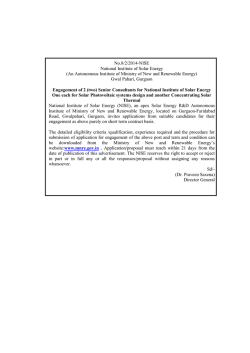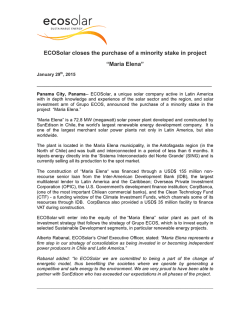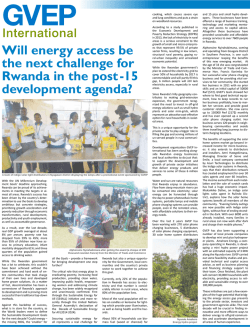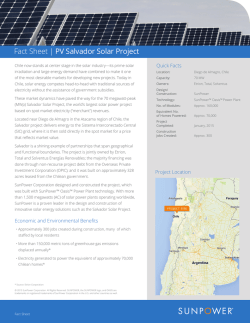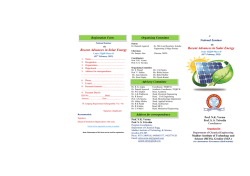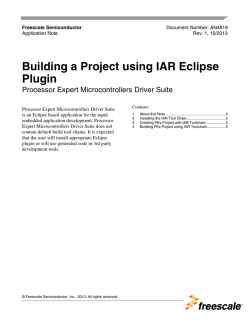
Indirect Observation Method
National Aeronautics and Space Administration Indirect Observation Method Introduction What is the Sun? If it is a star, why is it so much brighter than those we see during the night? If the Sun is so much brighter than the Moon, why do these two bodies seem to be the same size when observed from the Earth (this fact is even more evident during total solar eclipses when the new Moon covers the solar disk totally leaving only its corona visible)? Why do we not have a lunar eclipse at every new moon? Are solar eclipses visible everywhere on the planet? What is the difference between the mechanism of solar and lunar eclipses? Why do animals become agitated during solar eclipses? Why do some people associate the phenomenon to catastrophes and prophecies of the end of the world? These and countless other questions permeate the imagination of young students. Educators can take profit of the observation of eclipses as an efficient strategy to answer these and several other questions and curiosities related to this phenomenon, as well as to capture the interest of students in science. Fig. 1 - Sun and Earth in Scale. This image shows the relative sizes of the Sun and the Earth by placing them impossibly close together. Credit: NASA/JPLCaltech/R. Hurt (SSC). www.nasa.gov 1 Solar eclipses occur when the Moon, in conjunction (that is, between the Sun and Earth) crosses the ecliptic plan. Lunar eclipses, by its turn, occur when the Earth casts its shadow on the surface of the Moon, so that the Earth is between the Sun and Moon. These phenomena amaze students and educators at all scholarly levels, creating rare opportunities of getting them involved with science by means of the observation of a spectacle of such magnificence. Fig. 2 – Total eclipse of the Moon. This figure presents a sequence of images of a total eclipse of the Moon, from the start (right) to the end (left). This eclipse was visible only in the United States. Credit: © 2004 Fred Espenak. Despite the fact that some individuals feel tempted to stare at the Sun directly during a solar eclipse, this procedure is usually highly risky. As a matter of fact, certain cautions should be taken, aiming to protect the eyes during the observation of the Sun, at any time. The use of sunglasses is of minor utility, because they are inefficient in filtering the invisible and harmful infrared radiation that causes severe damage to the retina. Other improvised methods, such as observing the Sun in a bucket of water, or looking through dark plastics (such as x-ray material, for instance), are equally dangerous. Solar filters especially designed and certified can be used to observe the Sun. Nevertheless, a small imperfection in such devices would be enough to cause irreparable damage to the eye. Thus, this method is unsafe and therefore not recommended. Fig. 3 – Total solar eclipse of 2006. This composite image shows subtle structure in the Sun’s corona. Credit: © 2006 Fred Espenak. Eclipse Observation Activity for Grades 5-6, 9-12 2 Indirect Observation Method The safest method to observe solar eclipses is indirect projection. It can be utilized for the observation of solar spots, total and partial solar eclipses and transits of the planets Mercury and Venus. It can be also used to observe clouds as they move in front of the Sun. As the observer does not stare at the Sun directly at any time but only at a projected image of the Sun on a surface, risks to the eye are completely avoided. Nevertheless, it is necessary to be cautious to assure that students will not look through the projector (telescope, binoculars, etc.) directly, as this could provoke irreparable damage to the eye. It is necessary to take special cautions if children are involved. During the observation of solar eclipses, even during totality, when the solar disk is completely covered and only the corona is visible, the Sun should not be observed directly, as we do not know exactly the moment in which totality will finish, and sudden reappearance of the Sun could catch a distracted observer and provoke serious damage to the eye. 1. Target public: Primary and secondary school students. 2. Objectives: - To observe solar eclipses safely. - To promote awareness among students about the risks of staring at the Sun without proper protection. - To disseminate indirect projection as the safest method for observation of the Sun. - To encourage students’ interest in systematic scientific research. - To capture students’ motivation towards astronomy topics. 3. Materials: a) Apparatus 1 - 01 sheet of dark card; - 01 sheet of white paper; - 01 dowel or cutting object. Eclipse Observation Activity for Grades 5-6, 9-12 3 Fig. 4 – Projection card. Credit: Pedro S. Baldessar (UTFPR, Brazil). b) Apparatus 2 - The Pinhole Method - 01 rectangular box (such as a shoe box); - 01 dowel or screw; - white paper; - scissors; - glue. Fig. 5 – Projection box. Credit: Pedro S. Baldessar (UTFPR, Brazil). c) Apparatus 3 - binoculars; - 01 sheet of paper; - 01 dark cards; - 01 white card. Eclipse Observation Activity for Grades 5-6, 9-12 4 Fig. 6 – Projection method. Credit: Pedro S. Baldessar (UTFPR, Brazil). 4. Construction of the experiment and observational procedure a) Apparatus 1 i. Make a hole of about 2 mm on a sheet of dark card, which can be a more resistant surface. This hole can have an irregular shape. ii. Hold the sheet of paper or card in the direction of the Sun and turned to a sheet of white paper or another white surface, for projection. iii. The image of the Sun will be projected on the chosen surface and could be observed on that surface without risks to the eye. b) Apparatus 2 i.Using scissors, make a medium square on the top center part of the upper rectangular surface of the box (as shown in picture above), so that this square should form a lid that students could open to observe the projected image; Eclipse Observation Activity for Grades 5-6, 9-12 5 ii.Using a dowel or screw, make a small hole on one of the square surfaces of the apparatus; iii. Align the bottom of the box and the hole in the direction of the Sun; iv. Orient students to lift the lid of the apparatus and view the projected image of the Sun on the square surface of the box opposed to the one in which the small hole has been made; v. Observe the projected image of the Sun on this surface, and note that it is more accurate than the one provided by the previous apparatus, due to the fact that the projection environment is closed. c) Apparatus 3 i.Cover one of the lenses of binoculars with a card or similar opaque object in order to utilize only one lense of the device; ii.To reduce scattered light, use another card to produce shadow away from projection areas on the white card used for projection; iii. Place the projection card, preferably a white one, to receive light coming from the device; iv. Adjust the binoculars until it produces a sharp image of the borders of the solar disk; v.The image obtained by the use of this apparatus is still more accurate than those obtained by previous experiments because the binocular lense allows one to control convergence of the light coming from the Sun onto the projection card. Pedagogical Recommendations It is possible to capture the interest of students in space sciences by the observation of eclipses as well as to promote a proactive attitude amongst students, leading them to observe and carry out scientific recordings astronomical phenomena. In this way, they can experience the scientific method and have the singular opportunity to realize that in science we do not always find out what we expect, and that different groups observing the same Eclipse Observation Activity for Grades 5-6, 9-12 6 phenomenon may have different perceptions and reach different conclusions, because their “filters of reality” and expectations are distinct. It means that the subjective reality of the observer can lead to different procedures and result in a different “objective” reality for the observer. This curious phenomenon has been observed in the most diverse scientific fields, such as quantum physics, in which a physical entity can behave as a wave when no one is observing, or as a particle when an observer is present. Although classroom activities in science are not intended to prepare scientists, it is important to allow students to experience the scientific practice, either as a manner of socializing this practice and knowledge sometimes still perceived in a mystified way by general public, as well as to encourage them to choose careers in Science, Technology, Engineering and Mathematics STEM. During the observation, students could take pictures of the sequence of images they see projected on the white card, to record the hour that the Moon starts to project its shadow on the solar disk (that is, the moment when the eclipse starts), to measure how long totality lasts (in the case of a total solar eclipse), or to record the hour in which an eclipse finishes. The teacher should not impose one standard procedure on students, but instead present suggestions. One suggested procedure consists of explaining to the entire class how to construct their own projector to observe a solar or lunar eclipse. After that, the classroom can be divided into groups of 4-5 students. If observations are realized in a safe area, it is preferable to have teams work separately. The teacher should be knowledgeable, however, of where students are and visit teams several times in order to provide them guidance and further assistance. After recordings are complete, the class joins again and one representative of each group, elected by the students, presents results. This process allows socialization of different perceptions collected during the experimental activities in-situ. The objective of any experimental activity should not consist of simply giving back a written report to the teacher, but also leading students to share with their colleagues what has been learned, questions raised, observational methods employed, difficulties met, what interested them the most, among other impressions. This feedback could be used to enhance future classes. Furthermore, as students conduct oral presentations, they will develop some of the formalism used in the scientific community to communicate results. For instance, they would learn that such presentations should be formal, objective, concise, and consistent. Eclipse Observation Activity for Grades 5-6, 9-12 7 Space science constitutes one fundamental pillar to the scientific preparation of students just as the complexity of micro terrestrial ecosystems is immersed in a larger complexity of macro-scale ecosystems. That is, the space environment that, in the specific case of our solar system, is strongly influenced by solar dynamics, resulting in plasmas ejected during explosions occurring on the surface of that star, such as solar flares and coronal mass ejections. Several space science topics can be explored by the motivation of the observation of eclipses, such as the dynamics of the solar plasmas and space weather, in an integrated and meaningful approach. As follow-up, it is suggested further research on the history of eclipses, their impact on civilizations through the centuries and so forth, and guided visits to planetariums, scientific or space museum, space centers or similar places – this time, just for entertaining purposes, without related tasks. Science needs to be appreciated directly, and pre-college students should be encouraged to feel the pleasure and excitement of discovery and exploration. The paper “Eclipses through the Centuries” provides scientific and historical knowledge about eclipses, which can enrich discussion of this phenomenon that still amaze people all around the world. Credit: M.Sc. Norma Teresinha Oliveira Reis (Brazilian Ministry of Education – MEC, Summer Intern at NASA Goddard from May to August 2008). Mentors: Dr. Timothy E. Eastman, Dr. Louis Mayo and Dr. James Thieman (NASA Goddard). Collaborators: Dr. Fred Espenak (NASA Goddard), Dr. Nilson Marcos Dias Garcia and Dr. Pedro S. Baldessar (Federal Technological University of Parana State – UTFPR, Brazil), Paulo H. Silva de Oliveira (Brazilian Ministry of Education - MEC). Eclipse Observation Activity for Grades 5-6, 9-12 8 NASA Goddard Space Flight Center http://www.gsfc.sunearth.gsfc.nasa.gov/
© Copyright 2026
